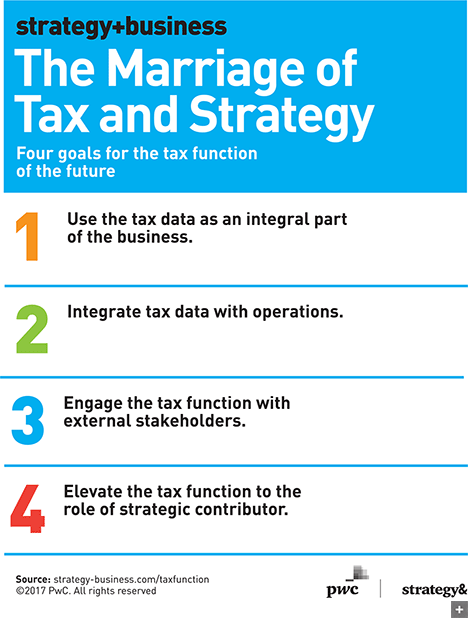The Marriage of Tax and Strategy
Make a commitment to the function that knows your company best.
A version of this article appeared in the Winter 2017 issue of strategy+business.
Tax discussions have the rare power to put senior executives to sleep yet keep them up at night worrying.
Business leaders have traditionally compartmentalized tax management as a compliance function, a complex specialty ceded to the experts. Although some C-suite executives have begun to realize that the tax function plays an important role in their overall strategy, it tends to operate relatively independently. When taxes do force their way onto the agenda of the CEO or the board, it is often in the context of bad news. Consider the uproar in the U.S. in recent years over corporate inversions, in which a U.S. company avoids paying U.S. taxes by buying a foreign company and moving its own headquarters overseas. And with the promise of some kind of tax reform under the Trump administration, the only certainty is that corporate taxes will continue to be headline fodder. On the other side of the Atlantic, the European Commission’s rulings against perceived cases of “state aid” in the form of favored tax treatment of certain companies can be costly to companies that are required to pay back their tax savings, as well as damaging to their reputation.
But to assign tax management entirely to a compliance role is to miss an important opportunity. In fact, executives should move quickly in the opposite direction: They should pull the tax function out of its silo and integrate it into the company’s daily operations. This function gathers data on every part of the business, including employees, assets, and intellectual property, in all territories. It’s one part of the organization where, at least once a year, you can be certain to find a comprehensive accounting of the entirety of the business.
This overarching perspective, of course, isn’t just “nice to have”; it’s increasingly necessary if companies are to communicate effectively with regulators and tax authorities. For example, multinational organizations are facing unprecedented challenges in the global tax environment as governments require greater tax transparency in the countries where they operate. Moves toward digitization of the tax system in a number of countries — Russia, Mexico, and Brazil are among those at the forefront — are also giving government tax authorities unprecedented amounts of transactional data about companies, often in real time. Because the tax function is pulling all this information together for regulators, it behooves the organization to use it more effectively in its own right. Thus, it is becoming a best practice to view the tax function as a strategic partner, one that helps set business priorities and gives the company a competitive edge. Otherwise, the tax authorities might have more insight into your company’s data than you do.
Indeed, even today, part of the reason this wealth of data is inaccessible and untapped at many organizations is that organizations have historically underinvested in the tax function. However, by digitizing, integrating, engaging, and elevating tax management, companies can begin to create the tax function of the future.
We have identified four goals that will improve taxoperations, make a company more competitive, and lessen the risk of noncompliance.
Goal one: Use tax data as an integral part of the business. Achieving this goal begins with a change in mind-set. The tax function is one of the largest consumers of data in an organization; virtually every transaction has a potential tax impact. A practice of examining the tax data that accompanies each transaction can help improve tax accounting, indirect tax, transfer pricing, general tax compliance, and tax dispute resolution. Moreover, proper organization of that data can give you greater insight into other parts of the business (for example, your company’s performance in different components of the supply chain or in gender pay equality).
Yet in a 2016 survey of manufacturing companies (pdf) by PwC and the Manufacturers Alliance for Productivity and Innovation (MAPI), only 15 percent of respondents said they frequently use the kind of business intelligence tools that would allow them to analyze tax data, and 57 percent reported no use at all of such tools. We would argue that there needs to be a shift in priorities throughout the organization: less time spent gathering and validating tax data, and more time spent analyzing and understanding the data.
Tax technology has lagged behind the development of wider enterprise resource planning (ERP) and financial software, although a rapid catch-up is under way. Until the last few years, at many companies, tax data was captured and reported in disparate spreadsheets and loaded into compliance tax software tools by hand. In some cases it has taken a while for senior managers to see a need to disrupt the stand-alone tax function with a technology overhaul, and members of the tax department might have resisted this technological integration themselves because of concerns about losing their unique role within the company. Yet when the integration takes place, it has the effect of reinforcing, not commoditizing, their value. Indeed, because it is a vital window into the company’s operations, the tax function needs access to the technological infrastructure of the rest of the company. This is especially true when the function is outsourced, because it continues to play a strategic role.
The finance function, as the main source of tax data, also needs to exchange information more effectively with the tax function. A failure to integrate tax data with other financial information can expose a company to financial statement errors, unnecessary controversy proceedings, and delays. Tax authorities are becoming less lenient with tax errors — intended or not — and quicker to impose penalties. For example, a European company that recently couldn’t reconcile its VAT returns with its Intrastat return (the cross-border movement of goods data) was hit with a €7 million (US$7.4 million) fine. Another company based in the U.K. that misstated its losses spent a year fighting a £10 million ($12.4 million) penalty, and the tax authority raised its risk rating. The publicity provoked by these sorts of errors and penalties also poses significant reputational risk to institutions.
With this kind of scrutiny as the norm, the tax function will need to take a leading role in making its data available and understandable throughout the organization.
Goal two: Integrate tax data with operations. When the tax function is digitized, advanced IT systems make it easier to integrate tax data with the organization’s systems and processes, all of which will improve operations. This is extremely helpful because most data used by the tax function for tax accounting, compliance, planning, and audit defense purposes does not originate within the tax function, but rather in corporate finance, ERP, consolidation, and other operational systems. In the PwC/MAPI survey, 53 percent of the respondents reported undertaking this kind of transformation in their finance or tax function, or in both, and an additional 15 percent said they were exploring the benefits of such an initiative.
It can be difficult to set up a system that gathers a broad base of company information in one place. The data can span multiple geographies, business units, financial systems, and debit/credit balances, and it is needed at a transactional level for every legal entity, including every country where the company does business. Once the needs of the tax function are integrated, however, data analysis can occur throughout the year in real time, which helps the organization adjust quickly and make better decisions. For instance, a company could identify and automatically correct an upstream data entry problem (e.g., incorrectly calculating the tax on an invoice or at the point of sale), avoid unexpected over- and underpayment of taxes, and reduce the cost of filings. Integrated tax information could additionally offer data about pricing per market, cost of products, cost of support services, and so on. Such a system could also provide analysis on, for example, whether a product in a certain jurisdiction is subject to 5 percent or 10 percent customs duty or is VAT exempt, then feed those considerations into pricing decisions.
Memo to the C-suite: Even if your company is operating within the law, public perception of your tax policies could erode trust.
The first step toward better enterprise-wide integration is a merging with other finance functions. The typical finance function, including tax, is responsible for core accounting and reporting activities such as period-end close and external tax and regulatory filings (e.g., audited financial statements, statutory accounts, and tax returns). In addition, finance undertakes other core operational accounting and compliance activities (e.g., payables, receivables, and sales tax compliance). Strong collaboration between tax and finance executives can help leaders identify potential problems and opportunities, including better ways to meet compliance requirements, gain efficiencies, and improve risk management.
Tax is a complex function, and it cannot deliver on its obligations without the support of the rest of the organization. Tax needs information and data from other functions for both decision making and compliance. It is thus necessary to integrate those functions and collaborate across the business, linking the front and back office to support the overall delivery of tax as a business issue within the organization. Once the needs and the integration requirements are understood, the organization can decide what will be managed in-house and what will be co-sourced or outsourced.
Goal three: Engage the tax function with external stakeholders. By digitizing and integrating the tax function, a company can begin to better engage outside stakeholders. In some countries, a more transparent data exchange and dialogue between the company and its regulators could bestow a number of significant benefits. It could create a stronger and less adversarial relationship with authorities; provide greater confidence with respect to tax positions; and achieve a lower risk rating (depending on the country), which could result in reduced audit or investigation risk and lower penalty and interest costs. In the long run, this could enable the company to build trust with a wider group of societal stakeholders than it had before.
Government officials are also increasingly interested in engagement and transparency. The Organisation for Economic Co-operation and Development (OECD), responding to concerns that the global economy loses as much as $240 billion annually in tax revenues owing to base erosion and profit shifting (BEPS) around the world, adopted a BEPS Action Plan in 2013. The plan calls for companies with an international presence to provide information on their global allocation of profit, the taxes they’ve paid in each country, and certain indicators of economic activity within the countries where they do business, such as where employees are located. This country-by-country reporting (CbCR) initiative, now in the implementation stage, will demand that companies develop a means of collecting, verifying, and reporting the compliance data. In addition, they’ll need a set of standardized and repeatable processes for analysis of the information so that they can identify any anomalies before and after they meet compliance needs.
CbCR is not the first transparency initiative, and it won’t be the last. But what makes this set of requirements stand out is the breadth of their reach and the impact on taxpayers, tax authorities, governments, and even the general public. By mandating that multinationals self-disclose standardized metrics, CbCR has raised the bar for transparency. Moreover, governments are engaging in unprecedented information sharing in order to assess risk and identify targets for audit. Tax audits and controversies are expected to rise dramatically as many governments seek more revenue by, for example, examining companies to ensure that the way they report the jurisdictions where they earn their profits accurately reflects their business model. As technology and data quality improve, organizations will find it easier to manage the process of allocating profits.
Members of the C-suite must recognize that even if they are technically operating within the law, the public perception of their tax policies could erode trust and hurt their brand. Unilever, a multinational company that has been notably transparent about taxes, states on its website: “Re-building public trust in the corporate tax system is vital — when broader taxpayer trust in the system is damaged people become less willing to comply and all taxpayers suffer as a result. Addressing public concerns that some multinationals are not paying their fair share of tax requires not only technical international tax reforms but also better efforts to improve public understanding and awareness.” Consistent with calls for greater transparency, the statement also says that providing user-friendly information about a company’s tax position to a broad range of stakeholders plays an important role in gaining public trust. In 2015, mining company Anglo American began publishing an annual report on its tax and economic contributions that included a detailed analysis of the taxes it paid and how those vary throughout the economic cycle of a mine. Companies will find it easier to make such promises if the tax function is prepared to help deliver on them.
Goal four: Elevate the tax function to the role of strategic contributor. Once the tax function is better integrated with the rest of the enterprise, a company can begin to use tax information to inform strategic decision making. By engaging in trend analysis, forecasting, modeling, and benchmarking with its peers, the tax function can become a value-added business partner, and an important contributor to proactive planning. The amount of money that a company pays, for instance, in real estate taxes or excise taxes could one day be measured as part of the operational overhead, similar to the way that such operations as IT or human resources are taken into account.
This final goal may be the least realized and most aspirational of the four, but many executives are beginning to grasp the potential in elevating the tax function to this strategic role. For example, at a simple level, improving data on the tax treatment of the costs of a building can enable a real estate company to better price lease costs for tenants. Similarly, by building tax analytics into supply chain modeling tools, a company can project the tax consequences of sales goals and anticipated transactions, adopting similar criteria on a market-by-market and product-by-product basis, all of which will be helpful in forecasting profitability.
A strategically focused tax plan would make it possible to consider the costs and benefits in such areas as credits and incentives, transfer pricing, and specific initiatives. A beverage company, for instance, would be able to review the disparity of indirect tax rates among substitute products for different types of alcohol. With that insight, the company could choose to focus lobbying efforts on fighting for a level playing field or on opening up new markets for itself, using elasticity data to support the arguments with governments for comparable treatment in cases where that would lead to increased tax revenues.
Tackling the Transformation
Most senior tax executives know that their tax function must evolve, but it’s challenging to chart a course that is not only effective but feasible in a world of budget and resource constraints. A critical first step is to assess the tax function’s current capabilities in governance, data, technology, process, and people. Is the tax function meeting today’s challenges as well as getting ready for those that lie ahead? Does it have the capacity to take on new responsibilities while efficiently performing tax compliance and financial statement obligations? Is it fully supporting the needs of the business, including responding quickly to planning requests that require analysis? Is it briefing the C-suite prior to shareholder meetings or press conferences? Does the cost structure of the tax function align with the variable and growing needs of the organization?
A company’s tax function effectiveness typically falls into one of five stages:
• Initial. The organization is mainly incident driven. The company uses basic accounting software, but it is not integrated, and no internal controls are in place. At this stage, there is a greater risk of unnecessary financial costs or other problems occurring, such as duplication of work, financial misstatements, and stresses on controls.
• Informal. Roles and responsibilities are mostly unwritten. There is no formal training, communication, or standardization. Licensed software is used with limited integration.
• Standardized. Processes are standardized, documented, and communicated. Deviations from written procedures may remain unnoticed. Minimally acceptable internal controls are followed. Technology includes a mix of licensed software and a tax-sensitized ERP or tax data hubs.
• Managed. Processes are actively monitored and continuously improved, and deviations are detected in time to avert problems. Technology tools are aligned with the overall organization and integrated, providing some predictive analytics.
• Optimized. Processes are efficient, based on leading practices, and continually monitored for improvement. The quality of deliverables is high. The organization can adapt quickly to changes in data or processes. Technology crosses functions with advanced automated workflow, embedded controls, and sophisticated analytics. At this stage, management has the critical information necessary for enhanced decision making.
Considering the changing demands in the tax arena, companies will need to constantly reassess their needs and effectiveness, developing a tailored, all-encompassing transformation road map. These are not static plans, and each company’s road map will depend on its current state, pain points, desired future state, and scope of feasible change, including what activities should be performed where — in the finance division, in the shared services center, or within the tax department. It will also specify whether the activities should be outsourced or co-sourced. Typically, the plan will cover multiple years with various options, depending on how phases are ultimately completed. The ideal road map pinpoints the specific capabilities that the tax function is striving to meet as well as the benefits and cost savings that will result.
In developing this road map for change (pdf), start with an overall view of the future state, identifying the expected gains in efficiency. Because transformation of this sort occurs on a dynamic and continual basis, be sure to plot key events but assume that others will happen spontaneously. Include explicit plans for early efforts to obtain buy-in from other stakeholders, along with the commitment of resources needed to make the road map a reality. Make use of existing enterprise technology where possible, but don’t preclude using new IT solutions if they are a good fit for the overall organization. At every stage, demonstrate how the tax function will actively participate. Most important, address talent gaps. Explore staffing, co-sourcing, and managed service options as alternatives to new hires.
Don’t create this road map in a vacuum. Here is your chance to show that the tax function is a vital element of the broader finance function. Work with other teams to leverage enterprise technology investments and design the tax function of the future. The key to success is to define your organization’s own unique tax strategy and make it part of the overall corporate vision.
Reprint No. 17406
Author profiles:
- Andy Ruggles is a partner with PwC US. Based in San Francisco, he oversees the national practice for PwC’s tax reporting and strategy, and specializes in the use of technology in the tax reporting, analysis, and compliance processes.
- Mark Schofield is a partner with PwC UK. Based in London, he plays a key role in the global and U.K. tax reporting and strategy business, which includes all of PwC’s services in the tax reporting, risk, strategy, technology, and corporate compliance arenas.
- Michael Shehab is a principal with PwC US. He is based in Detroit, where he is the leader of the tax technology and compliance practice. He has advised clients on large-scale tax transformation projects in multiple industries, including automotive, consumer products, financial services, manufacturing, and retail.





